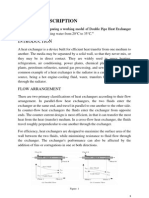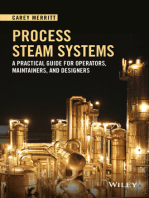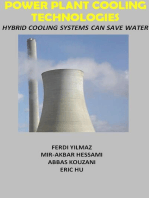Heat Recorery Systems: (I) High Overall Coefficients
Heat Recorery Systems: (I) High Overall Coefficients
Uploaded by
Philip ShihCopyright:
Available Formats
Heat Recorery Systems: (I) High Overall Coefficients
Heat Recorery Systems: (I) High Overall Coefficients
Uploaded by
Philip ShihOriginal Title
Copyright
Available Formats
Share this document
Did you find this document useful?
Is this content inappropriate?
Copyright:
Available Formats
Heat Recorery Systems: (I) High Overall Coefficients
Heat Recorery Systems: (I) High Overall Coefficients
Uploaded by
Philip ShihCopyright:
Available Formats
Heat Recorery Systems Vol. 2. No. 3. pp. 247-255, 1982 Printed in Great Britain.
0198-7593 82 030247-09503.00 0 1982 Pergamon Press Ltd
PLATE
HEAT
EXCHANGERS--A LOW-COST HEAT RECOVERY
ROUTE
TO
B. R. LAMB A.P.V. Company Limited P.O. Box No. 4, Manor Royal,Crawley, West Sussex, RH10 2QB, U.K.
Abstract--Plate (and Spiral) heat exchangers provide an excellent means of achieving highly efficient heat recovery because their high heat transfer coefficients, coupled with counter-current flow, enable them to produce close end-temperature differences--important in applying economies to low grade or poor quality heat. Examples are selected from experience and use over very many years in applying heat recovery as an integral part of processes.
INTRODUCTION
IN MOSTchemical processes one obvious way of conserving energy is to recover more of the heat which is dissipated to rivers, the sea and the air. Although much of this heat is at a relatively low temperature and therefore is not usually economically recoverable, some of it can be recovered with the aid of high-efficiency heat exchangers which operate economically with a close temperature approach at relatively low pumping powers. The Paraflow plate heat exchanger is just such a device and is ideally suited to the recovery of low-grade heat. Within its operational pressure and temperature range it is thermally extremely efficient. Heat transfer coefficients are usually higher than those in tubular heat exchangers for similar pressure loss; this, coupled with much lower fouling resistance at higher effective mean temperature differences gives designs of low surface area and therefore low price. For many industrial heat recovery duties, up to four or five years ago a design was considered economic if 85~ of the heat was recovered by recuperation. With the increase in energy costs the current thinking is nearer 92-93.0. As energy prices rise there is a greater need to provide cost effective equipment for energy conservation in all areas of manufacturing. APV has been working closely with manufacturers in numerous industries over many years and continuously developing equipment to meet their needs. Despite the fact that the first commercially successful plate heat exchanger was introduced by APV nearly sixty years ago, it is only recently that it has been considered a serious alternative to shell and tube exchangers for industrial heat transfer duties. This change has occurred with the introduction of multi-contact thin gauge plates which can be pressed in a variety of metals and modern rubber elastomers which have chemical and temperature resistance combined with good sealing properties.
ADVANTAGES O F PLATE HEAT EXCHANGER
The concept and construction of the plate heat exchanger has been well documented but in order to emphasise the advantages of plate heat exchangers over conventional heat exchangers, a summary of the main points are as follows:
(i) High overall coefficients
The shell side of the tubular is thermally inefficient--higher coefficients are obtained with the plate heat exchanger for similar pressure losses. Even in a well designed tubular unit large areas of tube are partially bypassed by liquid and low heat transfer areas thus created. Bypassing in the plate heat exchanger is minimal.
Paper first presented at conference 'Heat Recovering Systems in Process Applications', London, 20-21 October 1981. .,R.s. 2 3-B 247
248
B. R: LAMB
Fig. 1. (see text)
(ii) Mean temperature difference
The plate heat exchanger has the advantage of effective mean temperature difference. In the majority of applications the flow in a plate heat exchanger is counter-current and therefore the log mean temperature difference correction factor is 1. This is important when a close approach temperature is required, as occurs in more and more energy recovery systems involving low-grade heat. Figure 1 illustrates a typical plate arrangement for a single-pass design. The flow pattern through the plate passages is clearly indicated and shows the flow to be completely counter-current, thus resulting in no loss of efficiency by correction of mean temperature difference. For a given duty the plate heat exchanger is physically smaller and more compact. Depending upon the plate type, each cubic metre of plate heat exchanger contains 160 or 320 square metres of heat transfer area. By comparison, one cubic metre of tubular exchanger of equilateral triangular pitch with a tube pitch ratio of 1.5 has a surface area of 33 m 2 for 51 mm o.d. tubes or 132 m 2 for 13 mm o.d. tubes. If the ratio of heat transfer coefficient between plate and tubulars is conservatively taken as 2, the PHE volume to meet a given duty varies from 10-20~o of that of the tubular.
(iv) Fouling
Recent test work carried out by APV and Heat Transfer Research Incorporated (HTRI) of the U.S.A. has shown that PHE's have lower fouling characteristics than tubular units. The actual value of fouling factor used for designs depends not only on the characteristics of the process fluids but also the length of run. surface temperature and wall shear stress. Reduction in fouling_resistance is credited to four main features: (l) High degree of turbulence, which increases the rate of foulant removal and results in lower asymptotic value of fouling resd.stance: (2) good velocity profile across the plate: stagnant areas eliminated by the plate design; (3) corrosion maintained at an absolute minimum: (4) smooth heat transfer surfaces. The most important of these is turbulence. HTRI has shown that for tubular heat exchangers, fouling is a function of flow velocity and friction factor. Although flow velocities are low with the plate heat exchanger, friction factors are very high and this results in lower fouling resistance. The effect of velocity and turbulence is plotted in Fig. 2. The lower fouling characteristic of the plate heat exchanger compared to the tubular has been conclusively proved by HTRI test work. In common with all pressure retaining devices, plate heat exchangers have mechanical limitations above certain temperatures and pressures, but for waste heat recovery--as in many other industrial duties--pressure and temperature are moderate and Paraflows are
Plate heat exchangers
Effect
249
"
of velOCity Ond turbUlence
Tut>ulor
-P H E ~
s 5 f t
2 f?
s 8ft s
,,o
Time
Fig. 2. (see text)
therefore highly suitable since their thermal performance advantage becomes very significant for low temperature approach applications. An example is given in Table 1 illustrating the comparison between a plate and a tubular heat exchanger in which the recovery is 70% and, even at this level of recovery, there is a significant advantage for the plate heat exchanger. APV have been associated with heat recovery for many years inasmuch as the standard duty in a number of hygienic applications is pasteurisation in which a product is normally handled at room temperature but, for process reasons, needs to be heated to control, for example, bacteria, and then has to be cooled again to room temperature for storage. Typical examples are milk and beer. Pasteurisers have been in existence for well over 50 years and up until about five years ago it was generally accepted that something of the order of 85% recuperation was viable in terms of plant costs and energy consumption. Table 2. illustrates a typical pasteurising duty and gives an indication of costs and savings for two different recuperation designs. The pasteurising duty is typical of many applications where a product is stored at room temperature and has to be processed at elevated temperatures to control bacteria. The product is at 10C and is to be heated to 93C for pasteurising and then cooled to 10C for storage. It is to be processed at 22.7 m 3 h r - t. (5000 GPH). The cost of a Paraflow exchanger for 85% recuperation Section would be 6000 and for 92% recuperation 10000 and the difference in savings of steam and electricity is 69000. Perhaps five years ago with energy costs of the order of 2.2 to 1000 kg steam and electricity at 1 p/kWh the savings would have been about 20000.
Table 1. Comparison for heating 590000 kg h - 1 water from 23C to 36C using 590000 kg h - 1 water at 42C. Available pressure drops for both streams is 1.0 kg era- 2 Plate Heat Transfer Area [m 2] Heat Transfer Coefficient
[kcal h - t m - 2 C - 1]
Tubular
1218 1575 1361 5.8 1/1
(clean) (design)
448 3388 3173 5.6 0.32/0.33 0.00002 0.00002
Effective mean temperature difference [C] Pressure drop hot fluid/cold fluid [kg cm- 2] Fouling resistance [kcal h - 1 m - 2 C - t] Pass arrangement Approximate purchase price (July 1981)
hot fluid cold fluid
single pass both fluids
37500
0.0001 0.0001 4 tube side 3 shells in series
65000
250
B. R. LAMB Table 2
No heat recovery 85'!,, recuperation 10 77 .6--9_ 77- 93 6 8 0 k g h '~ 9_~'~,, recuperation 10--87 16-93 87 93 _~..'"~kgh -~
Heat recovery section temperature ranges [:C] Heat section temperature ranges [:C] Steam required: (assuming latent heat 1000 BTU l b - l) Cost/year at 8.00 per 1000 kg steam and for 6000 h / y e a r - t Cooling to 1 0 C using Cooling water (allowing off temperature of 49C) Cost of cooling water at 120 p/1000 gallons (Using tower water with say 100,o make up) Chilled water section temperature ranges [~C] at cost of 3 p k W h Total cost:
Nil 10-93 3 4 1 0 k g h -~
180000
36000
~14500
(a) Cooling water at 30~C to cool to 32 C (b) Chilled water to cool 32~C 10:C 73m3h 115200 11500 32-10 105000 296500 (using tower waterl 26-10 79000 I 15000 -16-10 31 500 46000 1
From these figures it is not unreasonable to suggest that this order of savings could or should have been in vogue five years ago. However, the design of plate exchangers had limits of the order of 89-90~o recuperation and with the need for higher heat recovery so the designs of plate geometry and pressings have been improved so that 92~0 is now readily achieved and APV are looking towards 94-95,0 recuperation.
PRACTICAL EXAMPLES OF HEAT RECOVERY
A heat recovery system using a plate heat exchanger is installed: in a synthetic fibres factory where hot process water requirements were originally met by mixing cold demineralised water with steam condensate from an evaporation plant. The desircto improve thermal efficiency led to a scheme (Fig. 3) for heating the cold demineralised water with evaporator overheads by means o f a heat exchanger. The condensate was thereby released to return to the boilerhouse. However, because of trace contamination risks, the returned condensate was not suitable for re-use in the boilers without an ion exchange treatment. This treatment is performed at 20C so a regenerative heat exchanger was required. APV supplied a plate heat exchanger with a heat transfer surface area of 3500 ft 2 designed to cool 39000 gat h- t of returned condensate from 82C lo 20C for
Poro~low
........
To
o,oo,
56-clj
Fig. 3.
d,5"c '
Cold rnoke-up wol"er
Plate heat exchangers
251
mixing for treatment. Treated water is then mixed with the necessary amount of fresh make-up water before passing forward to the plant at 56C. The energy savings involved in this scheme amout~ted to some 100000 per year. The important factor here was the ability to get a close temperature approach between the water to and from the ion exchange unit. The plate heat exchanger used is illustrated in Fig. 4. A further heat recovery scheme (Fig. 5) has been installed at a sulphuric acid company in London where, because it was the first of its kind in the U.K., qualified for a substantial grant under the Government's Energy Conservation Demonstration Project Scheme. In this process about 15Yo of the heat released at the absorption stage of the sulphuric acid plant is recovered and used to preheat boiler feed water. Two important features in this particular installation were the sulphuric acid required expensive alloy Hastelloy C
Fig. 4.
252
B. R. LAMB
..
84"C
Absorber acid 190"C
OTher aids
~ Ill
,.o, Pora,low ~
6).s'c
Paraflows ~
L
till
lili
L
mill
iili
2oc It|
ii
i!
B ~ e lw ~ t e ;
g 70"C ~lr
Fig. 5,
~Tower
worer
in order to keep the corrosion to minimum and it was also considered prudent to install a closed loop between the sulphuric acid heat recovery exchanger and the exchanger passing the heat into the boiler feed water. Although the scheme involved the use of expensive alloys and a separate Paracool loop, the estimated saving was 37000/year and the payback anticipated is about 18 months. Another recent installation relates to the re-use of heat from a power station. Twothirds of all the fuel that goes into producing electricity is wasted and most of this is discharged to atmosphere as reject heat via cooling towers. In some locations this lowgrade heat is being used for district heating but in the U.K. generating stations are usually isolated and applications are few. However, an enterprising venture has recently been established to take heat from the Drax Power Station to grow tomatoes. The tomatoes are grown under 20 acres of glass and kept at a constant temperature all the year round. Eight APV Paraflows are arranged in four groups of two to heat the solution that feeds the plant roots at the rate of 6400001-1 h- t. The reasons for using plate heat exchangers in this installation are that they give excellent heat transfer and take up very little space. Other very useful heat recovery schemes where Paraflow heat exchangers have been used to good effect include replacement of rack coolers in coke oven #ants .where the extra efficiency of the Paraflow has given closer temperature approaches resulting in a lower steam demand for the final heating--saving more than 1000 lb h - 1 of steam. Extra benefit obtained is a big reduction in maintenance costs. This is a typical example of savings that can be achieved using a more efficient type of heat exchanger.
S*'ril3oir~
C O U lm N
']TU
"U t_
.,oh
,,9 0 i l
j psteam
Wasl~
II
)ll
Fig. 6.
Plate heat exchangers
253
The process (Fig. 6) involves a stripping column (distillation columns are similar examples) where the feed liquor is supplied to the column at an optimum temperature to relate to the point at which the feed enters the column. This requires a steam heater to raise its temperature to the desired level. For the same column, the product leaving from the bottom section has to be cooled. Originally the benzolised oil was passed through a large oil/oil heat exchanger against hot debenzolised oil from the stripping still. Heat recovery was extremely poor and a 10C change of temperature was rarely achieved. Final cooling by an even larger serpentine cooler produced fouling problems with crystallised naphthalene which had to be removed at frequent intervals. The oil circuit was redesigned using two type-R55 Paraflow plate heat exchangers. There was an immediate improvement in heat recovery and a marked reduction in maintenance problems. The Paraflow preheats the benzolised oil by some 35C and saves something like 1000 lb h- 1 steam in the final heating. At the same time, it reduces the temperature of the debenzolised oil to 15C less than previously--hence a water saving on the final cooling. The second Paraflow completes the cooling. There are now several of these installations in operation and the plant engineers at the first plant report several added advantages apart from the obvious reduced steam and water costs--these include reduced installation space; reduced maintenance and fouling problems; better control of process temperatures; no atmospheric pollution; no contamination of cooling water. There is also a simple scheme for recovering heat from flue gases by using a spray recuperator with a plate heat exchanger in the spray water circuit to transfer the heat back to boiler feed water--simple in operation and effective in heat recovery (Fig. 7). As can be seen from the examples given, where there is a heat recovery scheme involving low grade heat, there is a need for an efficient heat exchanger which can achieve close temperature approaches between process liquid and the heat source, the need to avoid inefficiency in the design of the exchanger, i.e. cocurrent flow avoiding cross flow or parallel flow and, with most heat recovery schemes, the ability to provide the ironmongery at a comparatively low cost, these are all within the compass of the Paraflow range of exchangers.
SPIRAL PLATE HEAT EXCHANGERS
The spiral heat exchanger (or SHE) was introduced some fifty years ago for the paper and pulp industry and has since gained acceptance in other processes. Designs have
Boiler
Fig. 7.(see text)
254
B.R. LAMB
changed little during this period and the three types of spiral contain the same basic components a spiral annular heat transfer surface, a top cover and a bottom cover. The spiral is manufactured from two strips of sheet metal varying from 250 to 1500 mm wide and of suitable length to match the desired heat transfer area. The strips are carefully wound around each other into a double strip forming one channel for each fluid. The flow gaps, which are fixed by studs welded to the strips before winding, can be independently varied between 5 mm and 25 mm as required. SHEs may be manufactured in several grades of stainless steel, carbon steel and in copper and nickel alloys. They can operate at up to 20 bar pressure and at temperatures of up to 450C. The maximum surface area per umI is 200 m 2 and liquid flow rates of up to 300 m 3 h-1 can be handled. Advantages compared to shell and tube units include greater compactness, negligible maintenance, leakproof design, easy accessibility for inspection and cleaning, and low fouling characteristics. The SHE is ideal for liquid-liquid heat transfer whenever high-temperature heat exchanger is used in handling high-solid suspensions or slurries which tend to foul. or processing liquids which attack rubber elastomers. The compactness of the SHE has led to its wide acceptance on distillation plant for reboiling and condensing duties. In addition, its ability to fit into existing process plant and pipework makes it a useful addition for recovering heat from waste vapours and gases. Spiral heat exchangers are available in three distinct types. Type 1 is essentially for use on liquid-liquid duties where these duties cannot be handled by the Paraflow plate heat exchanger.
Coolant
In
fluid
~j~FHot v a p o u r / g a s in
i~ Coolant our
:Coolant O ~~
X \ J j o -.s, tI UU Lll =-1i . u _
oo, I /
Fig. 8.
oo,,,.,,o,..,
Plate heat exchangers
255
Type 2 is a cross-flow unit which, combined with variable gap geometry, is ideal for condensing large volumes of vapour which pass down through the open annulus formed by the cooling medium flow channel. Type 3 units combine features of both types 1 and 2 and are used for condensing and subcooling vapours. Cross-flow is employed during condensation while countercurrent flow occurs as the condensate flows outward through the closed part of its flow channel and is subcooled by the cooling medium. Spiral heat exchangers can be used over a wide range of industries for heat recovery systems and some typical examples are: coking plant-steel works--ammoniacal liquor, benzolised and debenzolised cooling and heating; sugar industry--raw sugar solution processing; sulphuric acid manufacture--oleum cooling; petrochemical industry--condensers; reboilers; pharmaceutical industry--sterilisation and pasteurisation of fermentation media and bacteriological effluent; sewage--heat treatment of raw and treated sewage sludge; vegetable oils and margarine--high temperature processing; pulp and paper industry--liquids containing fibrous solids; brewery and distilling--kettle vapour recovery; abbatoirs--recovery of heat from process vapours. Other uses are in solvent recovery, electrolyte cooling and sludge and slurry processes. Thus it can be seen that, with the choice available from either the Paraflow or Spiral ranges, it is possible to cover a very comprehensive range of heat recovery duties, particularly in the low-grade heat region and in many instances the payback period is extremely short.
You might also like
- Optimization of Shell and Tube Heat ExchangerNo ratings yetOptimization of Shell and Tube Heat Exchanger29 pages
- Boiler Fuel Savings by Heat Recovery and Reduced Standby Losses B. GrabsNo ratings yetBoiler Fuel Savings by Heat Recovery and Reduced Standby Losses B. Grabs7 pages
- Boiler Fuel Savings by Heat Recovery and Reduced Standby Losses B. GrabsNo ratings yetBoiler Fuel Savings by Heat Recovery and Reduced Standby Losses B. Grabs7 pages
- Understand Heat Flux Limitations On Reboiler Design PDFNo ratings yetUnderstand Heat Flux Limitations On Reboiler Design PDF10 pages
- Basic Refinery Equipment - Heat Exchanger (E003/1)100% (1)Basic Refinery Equipment - Heat Exchanger (E003/1)27 pages
- Ceramic Heat Pipe For High Temperature Heat RecoveryNo ratings yetCeramic Heat Pipe For High Temperature Heat Recovery11 pages
- Firetube Heaters: FIG. 8-31 Convection HeaterNo ratings yetFiretube Heaters: FIG. 8-31 Convection Heater7 pages
- 1999_Experimental_investigation_on_the_hysteresis_effect_in_vertical_two_phase_closed_thermosyphoNo ratings yet1999_Experimental_investigation_on_the_hysteresis_effect_in_vertical_two_phase_closed_thermosypho10 pages
- Nucleate Boiling Heat Transfer Coefficients of Flammable Refrigerants On Various Enhanced TubesNo ratings yetNucleate Boiling Heat Transfer Coefficients of Flammable Refrigerants On Various Enhanced Tubes5 pages
- Literature Review 2.1 Extent of Past WorkNo ratings yetLiterature Review 2.1 Extent of Past Work17 pages
- Optimization of Heat Exchanger Design for Oil and Gas RecoveryNo ratings yetOptimization of Heat Exchanger Design for Oil and Gas Recovery30 pages
- Improve The Efficiency of Heat Exchanger in Oil CoolerNo ratings yetImprove The Efficiency of Heat Exchanger in Oil Cooler29 pages
- Electrolytlc Cell Gas Cooling Upstream of Treatment CenterNo ratings yetElectrolytlc Cell Gas Cooling Upstream of Treatment Center2 pages
- Process Steam Systems: A Practical Guide for Operators, Maintainers, and DesignersFrom EverandProcess Steam Systems: A Practical Guide for Operators, Maintainers, and DesignersNo ratings yet
- Encyclopaedia Britannica, 11th Edition, Volume 8, Slice 3 "Destructors" to "Diameter"From EverandEncyclopaedia Britannica, 11th Edition, Volume 8, Slice 3 "Destructors" to "Diameter"No ratings yet
- Geothermal Energy: Sustainable Heating and Cooling Using the GroundFrom EverandGeothermal Energy: Sustainable Heating and Cooling Using the GroundNo ratings yet
- Sustainable Energy Conversion for Electricity and Coproducts: Principles, Technologies, and EquipmentFrom EverandSustainable Energy Conversion for Electricity and Coproducts: Principles, Technologies, and EquipmentNo ratings yet
- Thermal Modelling of Power Transformers Using Computational Fluid DynamicsFrom EverandThermal Modelling of Power Transformers Using Computational Fluid DynamicsNo ratings yet
- Thermodynamic analysis of geothermal heat pumps for civil air-conditioningFrom EverandThermodynamic analysis of geothermal heat pumps for civil air-conditioning5/5 (2)
- 1 Pdf 文件使用 "Pdffactory Pro" 试用版本创建: Www.Fineprint.CnNo ratings yet1 Pdf 文件使用 "Pdffactory Pro" 试用版本创建: Www.Fineprint.Cn78 pages
- Flashing Liquid Expanders For Crygenic Industries PDFNo ratings yetFlashing Liquid Expanders For Crygenic Industries PDF18 pages
- Flammability Characteristics of Combustible Gases and Vapor-Bulletin 627 Bureau of MinesNo ratings yetFlammability Characteristics of Combustible Gases and Vapor-Bulletin 627 Bureau of Mines129 pages
- Characterization of Styrene-Acrylonitrile Copolymer by Pyrolysis Gas ChromatographyNo ratings yetCharacterization of Styrene-Acrylonitrile Copolymer by Pyrolysis Gas Chromatography8 pages
- Copolymerization of Styrene and Acrylonitrile in Aqueous DispersionNo ratings yetCopolymerization of Styrene and Acrylonitrile in Aqueous Dispersion15 pages
- Performance of Shell-And-Dimpled-Tube Heat Exchangers For Waste Heat Recovery V. HNo ratings yetPerformance of Shell-And-Dimpled-Tube Heat Exchangers For Waste Heat Recovery V. H10 pages
- Modern Boiler Economisers - Development: and ApplicationsNo ratings yetModern Boiler Economisers - Development: and Applications17 pages
- Heat Recovery Analysis of A N Existing: C R U D E Distillation UnitNo ratings yetHeat Recovery Analysis of A N Existing: C R U D E Distillation Unit7 pages
- MTH, +, Q/ + o Ak O.: Heat Recovery Systems Vol. 5. No. 5, Pp. 441No ratings yetMTH, +, Q/ + o Ak O.: Heat Recovery Systems Vol. 5. No. 5, Pp. 4414 pages
- The S T U D Y of The Copolymerization of Styrene A N D Acrylonitrile To High Conversion. Application of Low Conversion Reactivity RatiosNo ratings yetThe S T U D Y of The Copolymerization of Styrene A N D Acrylonitrile To High Conversion. Application of Low Conversion Reactivity Ratios8 pages
- Lock Intro and Lock Gates Description Text DocumentNo ratings yetLock Intro and Lock Gates Description Text Document48 pages
- Yale Global King A-Frame Wire Rope Hoist 2014 Sept 11817505 Rev ABNo ratings yetYale Global King A-Frame Wire Rope Hoist 2014 Sept 11817505 Rev AB52 pages
- Heart Block Treatment in ParijatakAyurvedaNo ratings yetHeart Block Treatment in ParijatakAyurveda15 pages
- Matatag K To 10 School Mendez Elementary School Grade Four Teacher Kristel Marie L. Larraquel Subject A.P Date/Day July 29,2024 Monday Quarter 1No ratings yetMatatag K To 10 School Mendez Elementary School Grade Four Teacher Kristel Marie L. Larraquel Subject A.P Date/Day July 29,2024 Monday Quarter 14 pages
- Metals: Charpy Impact Properties of Hydrogen-Exposed 316L Stainless Steel at Ambient and Cryogenic TemperaturesNo ratings yetMetals: Charpy Impact Properties of Hydrogen-Exposed 316L Stainless Steel at Ambient and Cryogenic Temperatures14 pages
- GR-4/UN/V2: Common To Emergency Luminaire Converters Technical SpecificationsNo ratings yetGR-4/UN/V2: Common To Emergency Luminaire Converters Technical Specifications3 pages
- Check List For Submission of Building Plans Town Planning Department Required DrawingsNo ratings yetCheck List For Submission of Building Plans Town Planning Department Required Drawings1 page
- MARIAN VOICE SEMINAR WORKSHOP 2019copy Reading and Headline WritingNo ratings yetMARIAN VOICE SEMINAR WORKSHOP 2019copy Reading and Headline Writing5 pages
- Boiler Fuel Savings by Heat Recovery and Reduced Standby Losses B. GrabsBoiler Fuel Savings by Heat Recovery and Reduced Standby Losses B. Grabs
- Boiler Fuel Savings by Heat Recovery and Reduced Standby Losses B. GrabsBoiler Fuel Savings by Heat Recovery and Reduced Standby Losses B. Grabs
- Understand Heat Flux Limitations On Reboiler Design PDFUnderstand Heat Flux Limitations On Reboiler Design PDF
- Basic Refinery Equipment - Heat Exchanger (E003/1)Basic Refinery Equipment - Heat Exchanger (E003/1)
- Ceramic Heat Pipe For High Temperature Heat RecoveryCeramic Heat Pipe For High Temperature Heat Recovery
- 1999_Experimental_investigation_on_the_hysteresis_effect_in_vertical_two_phase_closed_thermosypho1999_Experimental_investigation_on_the_hysteresis_effect_in_vertical_two_phase_closed_thermosypho
- Nucleate Boiling Heat Transfer Coefficients of Flammable Refrigerants On Various Enhanced TubesNucleate Boiling Heat Transfer Coefficients of Flammable Refrigerants On Various Enhanced Tubes
- Optimization of Heat Exchanger Design for Oil and Gas RecoveryOptimization of Heat Exchanger Design for Oil and Gas Recovery
- Improve The Efficiency of Heat Exchanger in Oil CoolerImprove The Efficiency of Heat Exchanger in Oil Cooler
- Electrolytlc Cell Gas Cooling Upstream of Treatment CenterElectrolytlc Cell Gas Cooling Upstream of Treatment Center
- Process Steam Systems: A Practical Guide for Operators, Maintainers, and DesignersFrom EverandProcess Steam Systems: A Practical Guide for Operators, Maintainers, and Designers
- Encyclopaedia Britannica, 11th Edition, Volume 8, Slice 3 "Destructors" to "Diameter"From EverandEncyclopaedia Britannica, 11th Edition, Volume 8, Slice 3 "Destructors" to "Diameter"
- Geothermal Energy: Sustainable Heating and Cooling Using the GroundFrom EverandGeothermal Energy: Sustainable Heating and Cooling Using the Ground
- Sustainable Energy Conversion for Electricity and Coproducts: Principles, Technologies, and EquipmentFrom EverandSustainable Energy Conversion for Electricity and Coproducts: Principles, Technologies, and Equipment
- Process Intensification for Sustainable Energy ConversionFrom EverandProcess Intensification for Sustainable Energy Conversion
- Thermal Modelling of Power Transformers Using Computational Fluid DynamicsFrom EverandThermal Modelling of Power Transformers Using Computational Fluid Dynamics
- Thermodynamic analysis of geothermal heat pumps for civil air-conditioningFrom EverandThermodynamic analysis of geothermal heat pumps for civil air-conditioning
- 1 Pdf 文件使用 "Pdffactory Pro" 试用版本创建: Www.Fineprint.Cn1 Pdf 文件使用 "Pdffactory Pro" 试用版本创建: Www.Fineprint.Cn
- Flashing Liquid Expanders For Crygenic Industries PDFFlashing Liquid Expanders For Crygenic Industries PDF
- Flammability Characteristics of Combustible Gases and Vapor-Bulletin 627 Bureau of MinesFlammability Characteristics of Combustible Gases and Vapor-Bulletin 627 Bureau of Mines
- Characterization of Styrene-Acrylonitrile Copolymer by Pyrolysis Gas ChromatographyCharacterization of Styrene-Acrylonitrile Copolymer by Pyrolysis Gas Chromatography
- Copolymerization of Styrene and Acrylonitrile in Aqueous DispersionCopolymerization of Styrene and Acrylonitrile in Aqueous Dispersion
- Performance of Shell-And-Dimpled-Tube Heat Exchangers For Waste Heat Recovery V. HPerformance of Shell-And-Dimpled-Tube Heat Exchangers For Waste Heat Recovery V. H
- Modern Boiler Economisers - Development: and ApplicationsModern Boiler Economisers - Development: and Applications
- Heat Recovery Analysis of A N Existing: C R U D E Distillation UnitHeat Recovery Analysis of A N Existing: C R U D E Distillation Unit
- MTH, +, Q/ + o Ak O.: Heat Recovery Systems Vol. 5. No. 5, Pp. 441MTH, +, Q/ + o Ak O.: Heat Recovery Systems Vol. 5. No. 5, Pp. 441
- The S T U D Y of The Copolymerization of Styrene A N D Acrylonitrile To High Conversion. Application of Low Conversion Reactivity RatiosThe S T U D Y of The Copolymerization of Styrene A N D Acrylonitrile To High Conversion. Application of Low Conversion Reactivity Ratios
- Lock Intro and Lock Gates Description Text DocumentLock Intro and Lock Gates Description Text Document
- Yale Global King A-Frame Wire Rope Hoist 2014 Sept 11817505 Rev ABYale Global King A-Frame Wire Rope Hoist 2014 Sept 11817505 Rev AB
- Matatag K To 10 School Mendez Elementary School Grade Four Teacher Kristel Marie L. Larraquel Subject A.P Date/Day July 29,2024 Monday Quarter 1Matatag K To 10 School Mendez Elementary School Grade Four Teacher Kristel Marie L. Larraquel Subject A.P Date/Day July 29,2024 Monday Quarter 1
- Metals: Charpy Impact Properties of Hydrogen-Exposed 316L Stainless Steel at Ambient and Cryogenic TemperaturesMetals: Charpy Impact Properties of Hydrogen-Exposed 316L Stainless Steel at Ambient and Cryogenic Temperatures
- GR-4/UN/V2: Common To Emergency Luminaire Converters Technical SpecificationsGR-4/UN/V2: Common To Emergency Luminaire Converters Technical Specifications
- Check List For Submission of Building Plans Town Planning Department Required DrawingsCheck List For Submission of Building Plans Town Planning Department Required Drawings
- MARIAN VOICE SEMINAR WORKSHOP 2019copy Reading and Headline WritingMARIAN VOICE SEMINAR WORKSHOP 2019copy Reading and Headline Writing









































































































